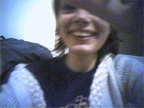September 06, 2005
Ars Electronica

Regine Blogs Ars
TEMPEST is based on the surveillance technology known as Van Eck Phreaking - computer screen content can be reconstructed remotely by picking up the emitted EM-field of the screen. TEMPEST utilizes this technique to transform purely generative graphic into a composition of noise which again is fed back into the image generating process. Several AM receivers are tuned into different frequencies of a screen and plugged into an audio mixer for further sound processing. The graphics on the screen become a means of producing sound and it is only the graphics which determine the different timbres and rhythms. By Erich Berger.
Interface Culture at the Linz University of Art was founded last year by Christa Sommerer and Laurent Mignonneau. The programme deals with human-machine interaction to develop innovative interfaces. Went to see their works yesterday.
SoundToy, by Christina Heidecker, Harald Moser and Timm Oliver Wilks, is a 3D environment you navigate as if you were a racing car driver. During the ride you use the steering wheel to create and compose 3D sounds. You place in the space sound objects assigned to electronic beats. The speed, pitch and volume can be individually adjusted using the steering wheel and the accelerating pedal. The composition is generated by the movement and position of the sound objects with respect to one another but also by the route you select.
Recipe Table, by Istvan Lorincz, Hanna Perner-Wilson, Thomas Wagner and Andreas Zingerle, is an interactive workplace built into a kitchen countertop that enable users to intuitively search for recipes. You place the tins and bottle, vegetable and other ingredients and in return the system makes you recipe suggestions. These culinary suggestions are also depicted graphically as finished dishes on the workplace.
Blow, by Taife Smetschka, is a breath-controlled video installation. There's a microphone and a projection of a clip from Billy Wilder’s film *The Seven Year Itch*, the scene in which Marilyn Monroe stands on the grate above the subway ventilation shaft. At first she is stationary, smiling at viewers from the screen. She doesn’t begin moving until she feels a cool breeze. In *blow!* the breeze has to be provided by the installation visitors who must blow as hard as they can into the microphone. Marilyn’s skirt flutters in the breeze as long as the visitor blows into the microphone.
Mika Satomi's Gutsie is a cyber android filled with “guts.” Peeping into its interior through its eye-like hole, you can observe its intestines in motion. It will show you the places you want to see by tracking your eye gaze, but at the same time, your gaze may infect it. The interior of our body is something very private, often disgusting, and thus prohibited to be seen or to be shown. In media, visual images of our insides are often used to induce feelings of violence or disgust. Ironically, this is something that is stuffed inside everyone’s body without exception.
The G-Player (Global player), by German artist Jens Brand, works like a CD-player. But instead of playing CDs, it plays the globe. The device knows the postion of more than a thousand satellites and enables you, by the use if a virtual 3D planetary model, to listen to an imaginary trace of a selected flying object. Like a needle on a record, the satellite follows the Earth's surface. The G-Player transforms the different elevations units course directly into sound. The simple display shows the selected satellite's name, type, altitude and position over the planet (thus the latitude and longitude). Topographic data are interpreted as audio data. "Noise sounds" result from the high density of the data. Pictures.
[via we-make-money-not]
Posted by jo at September 6, 2005 08:45 AM
